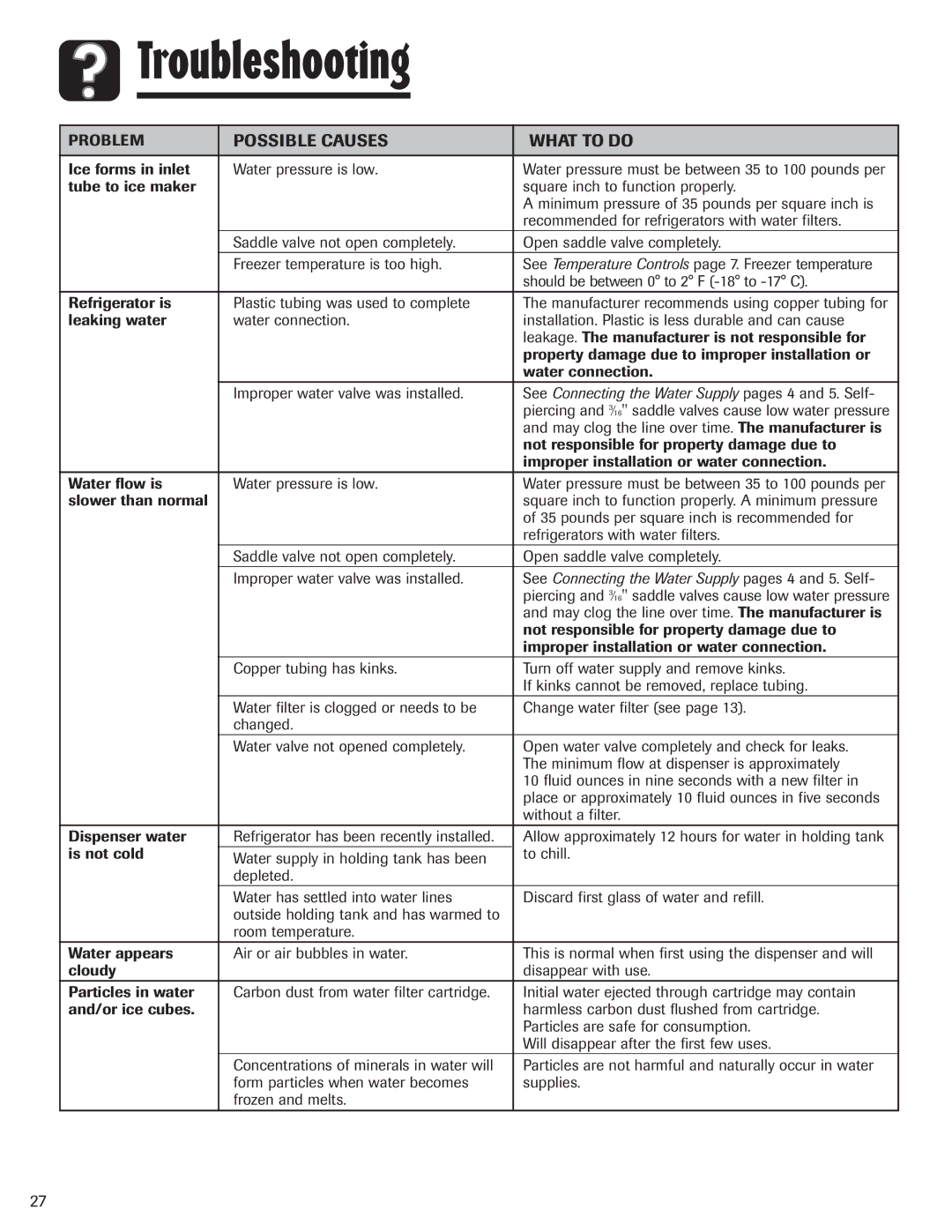 Troubleshooting
Troubleshooting
PROBLEM | POSSIBLE CAUSES | WHAT TO DO |
Ice forms in inlet | Water pressure is low. | Water pressure must be between 35 to 100 pounds per |
tube to ice maker |
| square inch to function properly. |
|
| A minimum pressure of 35 pounds per square inch is |
|
| recommended for refrigerators with water filters. |
| Saddle valve not open completely. | Open saddle valve completely. |
| Freezer temperature is too high. | See Temperature Controls page 7. Freezer temperature |
|
| should be between 0° to 2° F |
Refrigerator is | Plastic tubing was used to complete | The manufacturer recommends using copper tubing for |
leaking water | water connection. | installation. Plastic is less durable and can cause |
|
| leakage. The manufacturer is not responsible for |
|
| property damage due to improper installation or |
|
| water connection. |
| Improper water valve was installed. | See Connecting the Water Supply pages 4 and 5. Self- |
|
| piercing and 3⁄16" saddle valves cause low water pressure |
|
| and may clog the line over time. The manufacturer is |
|
| not responsible for property damage due to |
|
| improper installation or water connection. |
Water flow is | Water pressure is low. | Water pressure must be between 35 to 100 pounds per |
slower than normal |
| square inch to function properly. A minimum pressure |
|
| of 35 pounds per square inch is recommended for |
|
| refrigerators with water filters. |
| Saddle valve not open completely. | Open saddle valve completely. |
| Improper water valve was installed. | See Connecting the Water Supply pages 4 and 5. Self- |
|
| piercing and 3⁄16" saddle valves cause low water pressure |
|
| and may clog the line over time. The manufacturer is |
|
| not responsible for property damage due to |
|
| improper installation or water connection. |
| Copper tubing has kinks. | Turn off water supply and remove kinks. |
|
| If kinks cannot be removed, replace tubing. |
| Water filter is clogged or needs to be | Change water filter (see page 13). |
| changed. |
|
| Water valve not opened completely. | Open water valve completely and check for leaks. |
|
| The minimum flow at dispenser is approximately |
|
| 10 fluid ounces in nine seconds with a new filter in |
|
| place or approximately 10 fluid ounces in five seconds |
|
| without a filter. |
Dispenser water | Refrigerator has been recently installed. | Allow approximately 12 hours for water in holding tank |
is not cold | Water supply in holding tank has been | to chill. |
| depleted. |
|
| Water has settled into water lines | Discard first glass of water and refill. |
| outside holding tank and has warmed to |
|
| room temperature. |
|
Water appears | Air or air bubbles in water. | This is normal when first using the dispenser and will |
cloudy |
| disappear with use. |
Particles in water | Carbon dust from water filter cartridge. | Initial water ejected through cartridge may contain |
and/or ice cubes. |
| harmless carbon dust flushed from cartridge. |
|
| Particles are safe for consumption. |
|
| Will disappear after the first few uses. |
| Concentrations of minerals in water will | Particles are not harmful and naturally occur in water |
| form particles when water becomes | supplies. |
| frozen and melts. |
|
27
